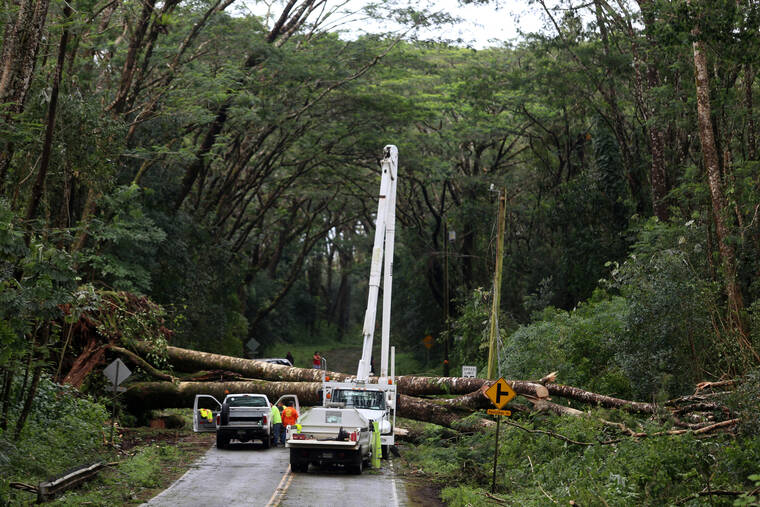As funding for albizia removal on the Big Island dries up, the invasive trees — and the danger they pose — are spreading again.
The fast-growing and brittle albizias have been a longstanding problem on the Big Island, which was emphasized in 2014 when Hurricane Iselle felled trees all over Puna, damaging homes and infrastructure in the process.
But despite strong initial progress in fighting the trees over the last eight years, funding has become harder to come by, leaving the future of the war on albizias in doubt.
“It’s a shame, because it really feels like we’re losing momentum,” said Franny Brewer, program manager for the Big Island Invasive Species Committee. “As it stands now, we most likely won’t have any albizia work funded beyond 2024.”
Brewer said that an Albizia Hazard Mitigation Plan drafted in 2015 has led to significant improvements in Puna, explaining that both the state Department of Transportation and Hawaiian Electric have reported noticeable reductions in fallen trees blocking roads or taking down powerlines over the last several years.
“A lot of the problems come from trees that are overhanging infrastructure, but their trunks are on private property, so DOT or Hawaiian Electric can’t do anything about them,” Brewer said. “So (BIISC) works on getting permission from the property owners, and the county works on getting authority to remove the trees however they can. … But that means there’s a lot of people involved, and some of these subdivisions have really small lots, so there’s a lot of property owners to talk to.”
However, she added that tree removal has always been expensive, and that a series of other crises — first the 2018 Kilauea eruption, then COVID-19 — has shifted resources away from the albizias.
In addition, the 2015 mitigation plan only covered a five-year period, which has long since passed.
Brewer said there have been meetings this year between BIISC, DOT, and the county Department of Public Works regarding a new mitigation plan, which may take shape sometime later this year. But for now, she said that the only albizia removal funding for BIISC this year is likely to come from state grant-in-aid funds.
Puna Councilwoman Ashley Kierkiewicz said she is hoping to better coordinate the county and state’s various albizia mitigation measures into a more effective whole. She said that, for example, residents are able to report problem trees on neighboring properties, which get added to a master list maintained by the mayor’s office.
But Kierkiewicz and Brewer both said there does not seem to be a mechanism for the county to act on those complaints.
Kierkiewicz also noted during a town hall meeting Thursday the same thing Brewer did: “Removing trees is expensive, yeah?”
Because of the high cost of removing trees — the BIISC website cites arborist estimates of more than $6,000 for a full-grown albizia — some property owners simply can’t afford to get rid of them, even though the potential damage they could cause would be far more expensive. Kierkiewicz said she wants to explore the possibility of a state fund that lower-income residents could access so they could afford to remove dangerous trees.
Brewer agreed, imagining a program set up similarly to the county’s pandemic-era Emergency Rental Assistance Program.
“I spend a great deal of time talking to people at the county and urging them to put together some kind of relief program,” Brewer said.
At the state level, there is one budget bill that would allocate an unspecified amount of money to the Department of Land and Natural Resources to coordinate albizia removal.
Two other albizia-related bills would have established incentives for businesses to develop ways to use albizia wood for commercial products, but have since died. Brewer said those bills were “interesting,” but added that albizia is expensive to harvest and isn’t particularly cost-effective to work with.
Email Michael Brestovansky at mbrestovansky@hawaiitribune-herald.com.






